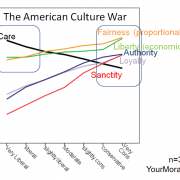The Moral Identity of an Organization Hinges on Leadership and Affects Everyone

One of the more interesting media shake-ups recently was Glenn Greenwald’s departure from The Intercept. Somehow, he lost control over the soul of a company he co-founded. To his eye, it lost its moral identity. Chief among its values, Greenwald has written, was “editorial freedom, the protection of a journalist’s right to speak in an honest voice, and the airing rather than suppression of dissent from mainstream orthodoxies and even collegial disagreements with one another.” Greenwald wanted to continue the sort of work he did with Edward Snowden—holding political power, Democrat and Republican, to account, but editors at The Intercept, he claimed, violated this core value repeatedly, eventually limiting his ability to, in the final instance, criticize the Biden family in the run-up to the presidential election. Fed up, last October, he moved his column to Substack, a personal newsletter platform where, to much media hullabaloo, he announced his resignation.
The question of moral identity, hardly anyone can now deny, is taking center-stage in our workplaces. Our offices—or our Slack channels and Zoom meetings—are increasingly a forum for contentious discussions about political and social issues, and what a company’s stance should be. This public layer of morality sits on top of the more business-oriented moral concerns of fairness, inclusion, equality and equity, work ethic, sustainable practices, and more. It would arguably be wise to understand how the moral identity of an organization, often set largely by the behavior of its leaders, can shift the attitude and conduct of its employees, because, as a growing body of research shows, this matters to company success.
Moral identity symbolization has an important role in organizations.
The moral identity of an organization stems from its culture around ethical issues, like the sort of conduct it encourages or condones among its leadership toward, for example, employees in the workplace, customers or clients relying on its services, or the environment. Much of the moral identity transmission that an organization could benefit from happens effortlessly at the office, where a large volume of formal and casual interaction takes place. Meetings, strategy sessions, office visits, and casual conversations at the caffeine machine. These are by default rich with body language, tone of voice, lengthy conversation, stories, asides, and a feeling of genuine connection.
Ethical leadership is primary. Research consistently underscores the importance of leaders demonstrating normatively appropriate conduct through personal actions and interpersonal relationships, and promoting such conduct to followers through two-way communication, reinforcement, and decision-making.
While a moral identity could contain many values, ethical behavior in the workplace is highly related to identities that emphasize being pro-social (benefits others or society) and less self-serving. The effects of a positive moral identity tend to be consistent across many situations, and in the most critical ethical conflicts or decisions, strong moral identities can help resist pressures to conform to group norms (reference norms) that violate the inner moral compass. Fundamentally, moral identity has two components, one that governs our ethical behavior and decisions (internalization) and another that relates to being seen by others as ethical (symbolization). Together these comprise an identity that is both private and public.
Moral identity symbolization has an important role in organizations. A leader with a strong moral compass, for example, is not likely to be an effective role model unless the private moral turbulence and determinations are made external for others to see. Followers may witness the moral identity of their leaders in part when it is expressed through ethical leadership, while moral attentiveness (considering moral implications with regularity) is likely to more directly influence followers when they see their leader participating in it. Yes, the internal moral struggle is likely to find its way to followers through more ethical behavior, but frequently thinking aloud about ethical questions, or describing the moral reasoning behind decisions, may also influence followers to adopt a similar moral identity.
An organization can promote the transmission of positive moral identity by ensuring that expressing moral values does not lead to backlash or ostracization (strong speak-up culture), and by providing opportunities for employees to speak up. This comes with considerable risks, of course, if it isn’t safe to speak because people inappropriately call out others they believe have done wrong. Through company culture, employee selection, and training, these risks can be limited but not eliminated. Failure to manage this successfully can be costly, as moral identity transmission may be reduced, or some employees’ ideas (often minority) are not heard.
Some may be hesitant to share their moral identities, in part because it might seem to them that seeking approval is superficial, arrogant, or egotistical. This humility, or reservedness, limits the transmission of their larger identity to others. Such people may be encouraged to express themselves by being explicitly invitated to share their thoughts, and being shown the value of these moral expressions beyond their own self-image.
The primary way moral identity, an important component of one’s self-concept, is influenced at work is through close personal relationships with mentors. Role models provide a reliable source of social learning. Seeing others share knowledge freely, especially when it’s personally advantageous to the mentee (e.g. success tips), teaches the value of knowledge sharing as part of moral identity. A leader can help build the moral identity of followers by providing them opportunities and guidance to discover who they really are through experiences where they are held accountable yet given autonomy to make decisions with ethical implications.
Virtuous leadership appears to be another way that a leader’s moral identity can lead to changes in the moral identity of followers. Consistent with both the accepted view that ethical leadership is learned in part by role modeling, and the evidence that externalizing moral identity is important to spreading similar values, virtuous leadership combines these into a well-defined set of behaviors. A 2020 paper defines it as “a leader-follower relationship wherein a leader’s situational appropriate expression of virtues triggers follower perceptions of leader virtuousness, worthy of emulation.”
Subscribe to the Ethical Systems newsletter
Moral identity may also trickle down in an organization. A 2009 study found that leaders impact the organization across levels of hierarchy. Though these effects have decreasing impact at greater distance on the organizational chart, additional factors determine whether a trickle, or a wave cascading through the organization, reaches lower-level employees. The people closest to an employee, formally or informally, are likely to have the most influence on their moral identity. There is strong agreement between close work associates as well as pressure to conform, a phenomenon known as “collective identity.” Work teams, departments, or social groups may demonstrate this group-level relationship. It could be formal team members, those who have banded together on projects or shared goals, or simply a group that has socially bonded.
Bias can limit the impact ethical leaders can have. A 2019 paper found that followers’ moral identity is more likely to be influenced by ethical leadership when the leader is viewed as highly prototypical of the group they lead.
Inspiring a change in moral identity within one group member might be an uphill battle without appealing to the entire group, when the group is cohesive and close knit. Work groups have high levels of agreement between members but also unique emergent properties at the group level, meaning that conducting measurement, research, and interventions at the group- rather than individual-level is sometimes beneficial. A group sharing a collective identity is expected to be influenced by ethical leadership nearest to them (e.g. supervisors, managers) in the hierarchy, more so than top management, for behaviors such as deviance and organizational citizenship. More proximal leadership also mediates the effect of top management leadership, highlighting the importance of leaders at lower levels.
A 2020 paper suggests that organizations should establish norms regarding moral approbation and perspective-taking. They should lay out, in other words, expectations for conduct regarding issues like compassion, embarrassment, guilt, and pride, bringing them into awareness and with specific guidelines. This approach sets the initial expectations, instead of letting these norms form organically in the group, which may lead to undesirable outcomes, such as climates of fear or guilt.
As it happens, the case of Substack can illustrate the broad importance of moral identity to organizations. Substack embraces a form of meritocracy driven by reader choice. Recently this company has grown, and with this growth has come scrutiny, from The New Yorker among others, on the relationship between their values and the effect of those values on their independent contributors, readers, and the landscape of journalism. Substack largely leaves it up to writers to earn or recruit their own readers. That wasn’t a problem for Greenwald, who decamped to Substack perhaps because of their expressed moral values. (E.g. “We believe in the free press and in free speech—and we do not believe those things can be decoupled.”) As a result Substack attracted a big name with, and perhaps for, their values.
But this may come at the cost of polarizing their readership. Greenwald is a left-libertarian, and his affinity for the platform has both attracted and repelled some of the readers and writers on the site. The effect of this on the minds of Substack readers and writers illustrates what might happen with the customers of other companies when moral identities—however laudable—are broadcast publicly.
How does this all play out in the context of remote work? If transmitting beneficial moral identities helps organizations, and neglecting to transmit moral identity is problematic, then there may soon be an unfortunate confluence, if not a looming crisis, as work becomes more remote.
The remote worker is likely to share the richness of being in the same room only with their cat. Supervisors and coworkers interact awkwardly at a distance, through stifled video chats, emotionless emails, and likely find limited synergy in commenting on shared online documents. We don’t necessarily know how to type our tone of voice or email our emotional emphasis, or take the time to explicitly include this content. How then will role models model? Will teaming up remotely create cohesion? Can collective identities be forged from afar?
These questions remain significantly unanswered, but taking a “go remote and find out” approach is probably imprudent. Instead, it’s likely a good idea to make visible and explicit the moral values on which employees base their identities, thoughts, and actions. Though these demonstrations of moral thinking are bound to be deficient at a distance. Allocating resources (time in particular) to interpersonal relationships, and ensuring that employees know—through shared media presentations, videos, or talks—that striving to reflect these values means as much as tangible productivity, would be wise. As a 2018 paper put it, “The more central a person’s moral identity is to the sense of self, the more important it is to the person to be moral.”
Brian Harward is a research scientist at Ethical Systems.





